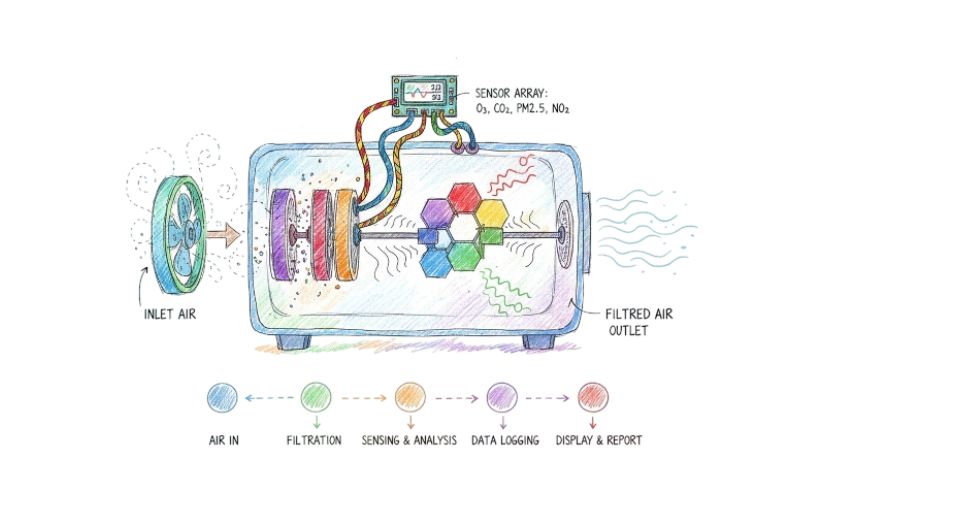
Oct 03, 2025

The global air quality monitoring system market by Metastat Insight captures an increasing awareness of the extent to which environmental conditions influence day-to-day life, productivity, and long-term health. From the congested streets of urban centers to industrial areas that drive economies but pose problems to public health, the capacity to quantify and comprehend air quality has transitioned from a niche undertaking into something of a necessity. Businesses, policymakers, and communities are directing attention towards instruments that not only identify pollution but also inform actions that build healthier environments. This growing significance indicates that monitoring technology is no longer backstage infrastructure but is now part of the front-of-mind discussion about sustainability, urban development, and healthcare resilience.
Industry backdrop
Air pollution and environmental degradation continue to be core issues today. Urban growth, industrial activities, and energy use increase the strain on natural systems, as societies demand more accountability for sustainability. Without measurement, solutions are shot in the dark. Monitoring technologies have become a means to fill the void, providing insight and decision-making based on facts. The systems offer real-time information, enabling regulators, organizations, and scientists to identify trends, evaluate risks, and design effective interventions. This makes them critical in directing economic activity towards environmental responsibility.
Function and value proposition
Air monitoring systems function by gathering, analyzing, and interpreting pollutant and atmospheric data. Their function goes far beyond sensor placement; these platforms convert raw data to actionable information. Companies employ them in order to monitor emissions and streamline compliance initiatives, whereas local government incorporates them into more comprehensive environmental initiatives in order to safeguard citizens. The technology is intended to gather information with precision and reliability so that interventions are based on solid evidence.
What characterizes contemporary solutions is flexibility of deployment. From being based at fixed locations in high-density places to being movable devices that track changing conditions, flexibility is ingrained in design. This enables monitoring to become extended to varied environments urban places, rural areas, industrial parks, and even indoor locations. Beyond regulatory compliance, the benefit is prevention. Through the ability to detect fluctuations early, societies and organizations can stay ahead of risk rather than respond to effects.
Evolution of the market
The evolution of this market follows consistent growth and not sudden change. Government policy and regulatory support initially spurred early adoption, but gradually, private business, research organizations, and even consumer-based organizations saw the need for trustworthy data.
Innovations have solidified the sector's position. Sensor miniaturization, connectivity of data, and integration with analytical platforms have increased usability and accessibility. What was once a major infrastructure expense has increasingly become streamlined and part of the broader digital transformation of industries globally. Interdisciplinary collaboration has also driven the path. Alliances among technology developers, health agencies, and policy makers generated momentum that kept monitoring from being trapped in specialized areas. This collaborative evolution is still refining precision, reach, and affordability, extending its impact in both mature and developing markets.
Regional dynamics
Global patterns of adoption differ. Developed nations have made large commitments to extensive monitoring networks, which are frequently tied to high-profile environmental objectives. These countries consider precise air quality information a cornerstone of public health policy and green innovation. Developing nations, on the other hand, are experiencing fast adoption as industrial development and urbanization require tighter controls over environmental conditions.
Areas that are in the process of rapid modernization hold great growth potential. The synthesis of growing populations, changing energy needs, and greater public conscience puts them at the forefront as potential implementers of monitoring technology. Both developed and developing regions see the emphasis put on maintaining industrial progress with sustainable existence at its center, making air monitoring systems the focal point of regional planning.
Barriers and prospects
In spite of momentum, there are challenges. High up-front costs, infrastructure gaps, and differences in regulatory systems can restrict application, especially in areas where resources are tight. Competitive forces also require ongoing innovation to make technologies stand out in a crowded marketplace.
But opportunities are vast. Unending innovations in digital integration, such as cloud platforms and data-sharing ecosystems, are opening doors. Growth into applications other than conventional government use healthcare, education, and commercial property real estate presents new opportunities for embrace. Synergies with wider sustainability initiatives, smart city initiatives, and industrial automation feed long-term applicability. The combination of environmental imperative and technological potential guarantees enduring demand and innovation.
Why attention is important
Air monitoring stands at the crossroads of health, sustainability, and digital transformation. International focus on climate change, increasing urban populations, and demand for transparent data make it a technology whose applicability cannot wait. It makes it possible to take forward-looking action to safeguard public health, inform policy with evidence, and assist industries targeting responsible growth.
The global air quality monitoring system market from Metastat Insight shows how technology is not just solving today's problems but also mapping the way towards a greener and healthier tomorrow. By coupling environmental accountability with technological advancement, these systems are becoming a critical part of the way societies evolve to meet contemporary realities and pave the way for decades to come.
Drop us an email at:
Call us on:
+1 214 613 5758
+91 73850 57479